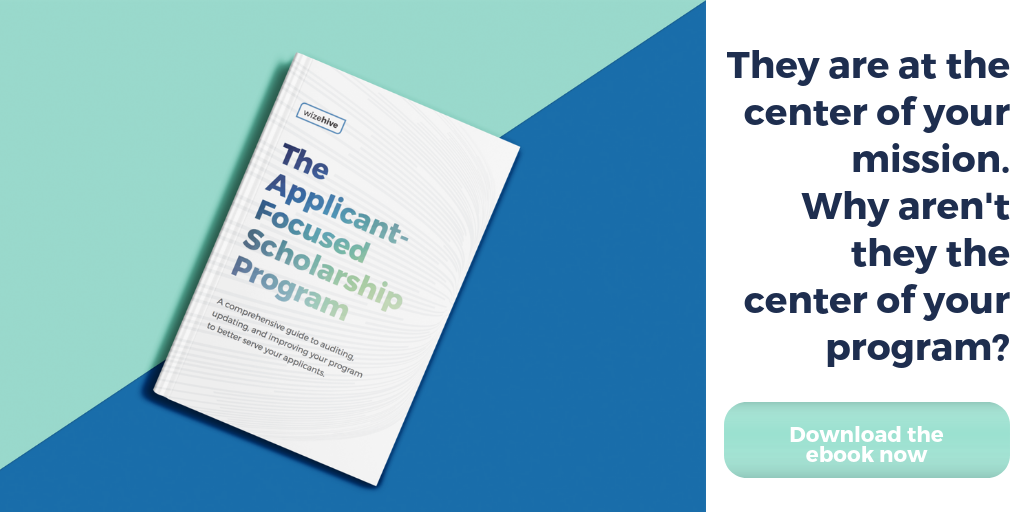Classic scholarship application questions - profile, essay, letter of recommendation - are tried and true, but are they optimal? More importantly, are they really helping you select the best awardees? If you're ready to mix it up and explore new ways to get to really know your scholarship applicants, read on.
For decades, scholarship application questions have required hopefuls to pen an often long, predictable essay on a set topic. A fairly dry or basic prompt like "where do you see yourself in 10 years?" is the norm.
While students have dutifully filled these in, have they really aided the review teams at the foundations offering these scholarships in determining the right applicant to award?
If the goal of the essay is to get to know the applicant personally, it’s imperative to think of other ways to allow them to share that insight -- perhaps in a way that doesn't stress them out or that caters to their strengths since not everyone is a writer.
We know better. Let’s do better.
Today, both scholarship program managers and student applicants have access to different modes of communication & technology - use it!
Your applicants are avid users of technology and carry a whole suite of creative applications around with them in their pockets. The way that they best express themselves and their aspirations is certainly multi-faceted these days and can’t be confined to a written essay.
The scholarship essay purpose has always been the same: show us something that can’t be reflected on a resume or transcript. It’s the student’s chance to highlight who they are, what their personality is like and to express their passion and enthusiasm. Today’s teens and young adults are more adept than ever at creative expression in various ways simply because they’ve had access to more options their whole lives.
Creating a photo journal, video essay, or slide deck presentation is much more intuitive to many of them than writing a five-paragraph essay. Imagine the possibilities that open up to them when they are allowed to show their purpose and passion in a way that fits their daily life. They get to express themselves in a comfortable way and showcase their creative and technical skills, and reviewers get to see an authentic side of applicants that a traditional written essay just can’t get to the heart of.
How to organize it
It all sounds well and good to allow students to submit various forms of creative expression, until you really think about the logistics of organizing all of those files and ensuring sure they’re uploaded in an easy and accessible way. Making the process easy, direct, and intuitive is essential to organizing the information you need to gather from your prospects and helping your review team do their job.
With a scholarship management system, you can easily collect all the necessary files directly through the application, help keep applicants on track timers and email or text reminders of when the application is due, manage all pieces of the application in one administrator database, and seamlessly share all the assets, no matter the file type, with the appropriate reviewers.
Many institutions have stuck with the old way because they know how to work that process and they’re scared to move to something different. But when a scholarship management system is custom made for your particular institution to match your workflow, it can only improve your process.
How it benefits your institution
Increase in creative & qualified applications
As you broaden the scope of how students are able to express their passion, you will inevitably yield more creative applications. When you have limited resources available to award to applicants, you want to make sure you choose the absolute best candidates. When applicants are allowed a bit more free rein in how they open up to you, the selection of the best candidates becomes a much more confident choice for your institution.
Because a transcript or resume can only show a snapshot of someone’s experience and background, many of the “intangibles” of a highly qualified applicant go unnoticed. When applicants are able to employ a wide array of expressive technology, they begin to stand out to your reviewers in a whole new way.
More robust information for reviewers to consider
Think about the job of your reviewers: sit at a computer and read through answers to the same essay prompt over...and over...and over. At a certain point, the human brain cannot do the same thing again and again at full attentive capacity. Allowing applicants to submit various different creative application materials means your reviewers will have much more interesting and relevant content to review and consider. Engaged reviewers are effective reviewers. And effective reviewers are equally as important as highly qualified applicants in the scholarship process.
Streamlined excellence and growth
Especially when you employ an online scholarship management system, this more creative application process will mean your scholarship program grows in ways that the old way just doesn’t have access to. You’re able to allow applicants increased creative options, make the review process simple and more engaging, and gain insight on impact stats so that you can grow the funding portion of your scholarship program as well.
Some of the most progressive and prestigious institutions are growing their application processes to include a wide range of creative tech options for applicants. Higher education is changing at breakneck speed and becoming more competitive than ever. It’s key to stay ahead of the curve so that your programs stand out, and it all starts with the application process. Let’s make submitting your application a memorable experience, and not just something that needs to get crossed off the list.
